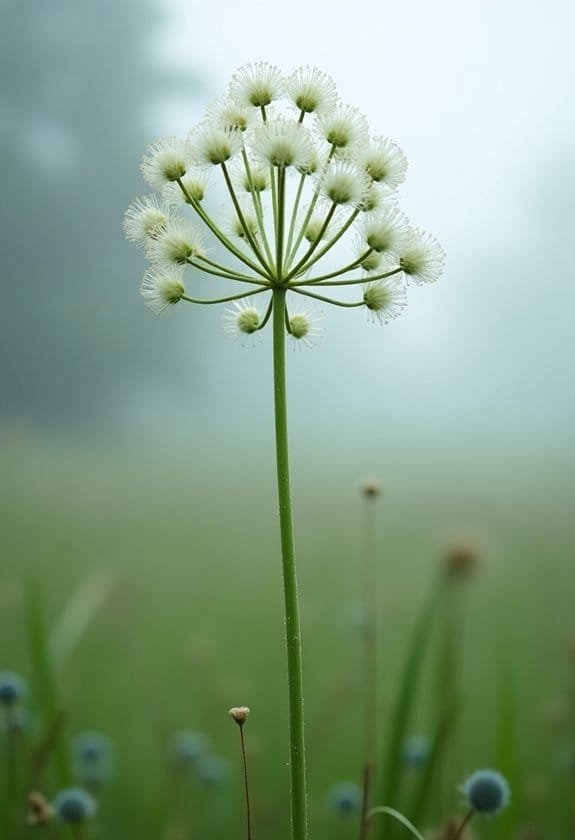Wild Angelica (Angelica sylvestris) is a striking European native plant that thrives in damp meadows and woodland areas, reaching impressive heights of 1-2 meters. It's characterized by robust, purple-tinged hollow stems and large umbrella-shaped clusters of white or pinkish flowers that form expansive umbels. The plant's divided lower leaves and prominent upper foliage create a commanding presence in temperate zones, where it prefers moist, rich soils and partial shade conditions. While historically valued for medicinal and culinary purposes, Wild Angelica's adaptability and reproductive success have led to invasive tendencies in certain regions, particularly Canada. Understanding this plant's complex ecological role opens a fascinating window into European flora's rich heritage.
Main Points
- Wild Angelica is a European plant growing 1-2 meters tall with purple-tinged hollow stems and white umbrella-like flower clusters.
- Found naturally in damp meadows and woodland areas, this plant prefers moist, rich soils and partial to full shade conditions.
- The plant features large divided leaves and produces small fruits with wings for seed dispersal, spreading effectively in suitable environments.
- Historically valued for medicinal and culinary uses, Wild Angelica attracts beneficial pollinators like bees, wasps, and butterflies.
- While beneficial in native regions, Wild Angelica can become invasive in certain areas, requiring monitoring to prevent ecological disruption.
Introduction

Angelica sylvestris, commonly known as Wild Angelica, is a towering perennial plant that graces wetland habitats across Europe with its distinctive purple-tinged stems and umbrella-like clusters of flowers.
This robust member of the Apiaceae family can reach impressive heights of up to 2 meters, featuring hollow stems and large compound umbels adorned with delicate white or pinkish blooms.
While valued for its historical uses as both a food source and natural dye, Wild Angelica has emerged as an important ecological species, though it carries the potential to become invasive in certain regions beyond its native range.
Common Name
Commonly known as Wild Angelica, *Angelica sylvestris* bears this name due to its prevalence in natural habitats across Europe. This robust plant thrives particularly in damp meadows and woodland areas, where its distinctive purple-tinged hollow stems rise prominently above surrounding vegetation.
The plant carries an alternative name, "European Angelica," which helps distinguish it from its more domesticated relative, Garden Angelica. This naming convention reflects not only its geographic origin but also its untamed nature in comparison to its cultivated cousin.
The leaves of Wild Angelica, along with its sturdy stems, have historically served as both food and medicine, contributing to its enduring presence in European botanical tradition.
The name "Angelica" itself carries a fascinating etymology, rooted in medieval beliefs about the plant's protective and healing properties. This celestial association reflects the high regard in which the plant was held, as it was thought to possess almost miraculous medicinal qualities.
Today, while its mystical associations have faded, Wild Angelica remains a significant species in both botanical studies and traditional European herbal knowledge.
Scientific Name
The woodland herbalist's treasure, *Angelica sylvestris* L., belongs to the diverse Apiaceae family alongside familiar plants like carrots, parsley, and fennel. The scientific naming of this majestic plant reflects its natural habitat preferences, with the specific epithet *sylvestris* directly translating to "of the woodland," highlighting its affinity for forested environments.
In botanical nomenclature, the genus name Angelica carries historical significance, while the binomial classification *Angelica sylvestris* precisely identifies this wild species among its numerous relatives.
The taxonomic placement within the Apiaceae family is evident through the plant's characteristic umbelliform flower structure and hollow stems, which can reach impressive heights of up to 2 meters. This scientific classification helps distinguish Wild Angelica from other members of its genus, particularly in temperate European regions where it naturally occurs.
The plant's taxonomic identity is further reinforced by its distinctive purple-tinged stems and robust flower umbels, which emerge during its summer blooming period from July through September, making it a recognizable specimen in its native range.
Overview
Standing tall among Europe's native flora, Wild Angelica (*Angelica sylvestris*) commands attention with its robust purple stems and spectacular umbels of white to pink flowers. This impressive perennial plant reaches heights of 1-2 meters, creating a striking presence in its natural habitats during its summer blooming period from July through September.
The plant's distinctive features include its hollow stems, which display a characteristic purple hue, and its intricate clusters of flowers white to pale pink in color. These blossoms, arranged in rounded umbels, serve as essential nectar sources for various pollinators, contributing to local ecosystem diversity.
Wild angelica demonstrates remarkable adaptability, flourishing in diverse environments from damp meadows to woodland edges and ditches, while tolerating an array of soil conditions.
Throughout history, this versatile plant has served both culinary and practical purposes, with its edible stems and leaves being consumed either fresh or prepared through cooking.
While it's considered a beneficial native species in much of Europe, particularly in the British Isles, its vigorous growth has led to concerns about invasiveness in certain North American regions, including parts of Canada.
Key Features
Wild Angelica stands as an impressive herbaceous plant, reaching heights of up to 2 meters with its robust, hollow stems that often display a distinctive purple tinge.
The plant's most striking features include its large, rounded umbels of white or pinkish flowers, which grace the landscape during its peak blooming period from July through September.
Its architectural form is further enhanced by divided lower leaves and prominent upper leaves with inflated petioles, creating a bold silhouette in its natural habitat.
Growth Size
Reaching impressive heights of 1 to 2 meters, Angelica sylvestris commands attention with its robust stature and distinctive purple-tinted stems. Wild angelica likes to establish itself as a dominant presence in its habitat, where its hollow, ridged stems create a striking architectural form in both natural and cultivated settings.
The plant's substantial framework supports an array of broadly divided lower leaves, which exhibit a remarkable compact proportion of less than 1.5 times longer than wide. These leaves, arranged in a systematic pattern along the stem, culminate in characteristic triple-leaflet formations at their terminals, contributing to the plant's commanding silhouette.
During its growth phase from July to September, the structure supports expansive umbels of diminutive white to pink blossoms, which are strategically spaced to maximize pollinator access. The plant's impressive vertical development is complemented by its reproductive strategy, producing fruits measuring 4-5 mm in length, equipped with broad lateral wings for effective seed dispersal.
This combination of height, sturdy stem structure, and well-organized foliage makes Angelica sylvestris a remarkable presence in diverse ecological settings.
Appearance
Angelica sylvestris stands out with its distinctive purple-tinged stems and striking architectural form. The plant's hollow stems rise majestically from the ground, creating an impressive silhouette that can reach heights of up to 2 meters, with noticeable reddish coloration at the leaf nodes.
The foliage presents a fascinating arrangement, with lower leaves exhibiting divided patterns that maintain a balanced proportion, being less than 1.5 times longer than their width. Upper leaves feature prominently inflated petioles, while the entire plant maintains a smooth, glabrous surface that gives it a refined appearance.
The crown jewel of this magnificent plant is its flowering display, where delicate white or pinkish blooms, each measuring approximately 2 millimeters, cluster together in rounded umbels. These floral arrangements create an ethereal canopy that attracts pollinators and adds visual interest to light, sandy soils where the plant often thrives.
The plant's fruit adds another dimension to its appearance, featuring oval-shaped structures measuring 4-5 millimeters in length, complete with thin, wing-like membranes that catch the breeze.
Flowering Season
The flowering spectacle of *Angelica sylvestris* unfolds from July through September, transforming the plant's already impressive stature into a hub of pollinator activity. During this vital flowering duration, the plant showcases its distinctive rounded umbels, adorned with delicate white to pink blooms that measure a mere 2 millimeters in diameter.
The pollination significance of this species is exemplified through its strategic flowering pattern, where 15 to 40 rays form each umbrella-like cluster. The central umbel leads the reproductive cycle, maturing into fruit while the surrounding umbels maintain their floral display, extending opportunities for insect visitors.
As seasonal changes progress through the late summer months, these architectural blooms undergo a remarkable transformation. The developing fruits take on rich brown hues and develop thin, wing-like membranes that aid in seed dispersal. This evolutionary adaptation guarantees the plant's survival strategy continues well beyond the flowering period, as the membranous wings allow the seeds to travel effectively on autumn breezes, establishing new colonies for future seasons.
Growing Requirements

*Angelica sylvestris* requires specific growing conditions to thrive, with a strong preference for moist, rich soils found near water sources and partial shade to full sun exposure.
The plant adapts remarkably well to various soil types, including sandy, loamy, and clay compositions, though it performs best in well-draining substrates with consistent moisture retention.
Ideal growth occurs in temperatures typical of temperate zones, where the plant can establish its robust root system while maintaining access to regular water, which is essential for its development into a full-sized specimen reaching up to 2 meters in height.
Light
Growing successfully in partial to full shade, wild angelica demonstrates its adaptability to various light conditions while showing a clear preference for shadier spots that mirror its natural woodland habitat.
The plant's light adaptation strategies enable it to thrive in locations where sunlight filters through tree canopies, typically receiving between 2-4 hours of direct sunlight daily.
Understanding shade tolerance levels is essential for ideal growth, as Angelica sylvestris has evolved to utilize diffused light effectively through its broad, compound leaves.
While the plant can tolerate periods of brighter exposure, especially in cooler climates, excessive direct sunlight may cause leaf scorching and increased water stress.
The ideal light exposure for wild angelica typically occurs in woodland edges or beneath deciduous trees, where light intensity naturally fluctuates throughout the growing season.
In garden settings, this natural pattern can be recreated by positioning plants where buildings or larger perennials cast partial shade, ensuring the delicate balance between sufficient light for photosynthesis and protection from intense afternoon sun.
Soil
Soil conditions play a pivotal role in the success of wild angelica, with its remarkable ability to flourish in light sandy, medium loamy, and heavy clay compositions. This versatile plant demonstrates exceptional adaptability across varying soil structures, making it a resilient choice for diverse growing environments. The soil composition directly influences the plant's development, though it exhibits notable flexibility in its requirements.
While Angelica sylvestris can tolerate different soil types, it shows a marked preference for moist, nutrient-rich environments, particularly those found near water sources such as marshes and drainage areas.
The drainage importance can't be overstated, as the plant thrives in well-draining soils that retain adequate moisture without becoming waterlogged. Effective nutrient management plays an essential role in optimizing growth, especially in cultivated settings where soil fertility can be actively monitored and adjusted.
Gardeners looking to cultivate this species should focus on maintaining consistent soil moisture levels while ensuring proper drainage, creating an environment that mimics the plant's natural habitat. This balance of moisture retention and drainage capability supports robust growth and helps establish healthy root systems.
Water
Throughout its growing cycle, adequate water supply stands as a critical factor for Angelica sylvestris's development. This moisture-loving plant demonstrates remarkable adaptability to various aquatic environments, particularly thriving in locations where water naturally accumulates, such as marshlands and woodland peripheries.
Implementing effective water conservation strategies becomes essential when cultivating Angelica sylvestris, especially in managed landscapes that mightn't naturally retain sufficient moisture. The plant's contribution to aquatic ecosystem benefits is significant, as its extensive root system helps prevent soil erosion along waterways while providing habitat for various wetland species.
To guarantee peak growth, moisture retention techniques, such as mulching and strategic placement near natural water sources, prove invaluable for maintaining the plant's required hydration levels.
In gardens and landscaped areas, regular irrigation must be maintained during dry spells to support the plant's impressive vertical growth of up to 2 meters. The species' natural affinity for wet conditions makes it particularly well-suited for rain gardens, where it can effectively utilize collected stormwater while adding architectural interest to water-conscious landscape designs.
Temperature
Temperature plays a pivotal role in Angelica sylvestris's growth cycle, with the plant showing ideal development in cooler, temperate climates. Through careful temperature impact analysis, researchers have determined that this robust perennial performs best when temperatures remain between 20-25°C (68-77°F) during its active growing period.
The plant's temperature adaptation strategies allow it to withstand occasional frosts, demonstrating its resilience as a woodland species. Like many of its forest-dwelling relatives, Angelica sylvestris has evolved to thrive in sheltered environments where temperature fluctuations are moderated by tree canopy cover.
A temperature range comparison with similar species reveals its preference for cooler conditions, making it particularly well-suited to northern temperate regions.
For best cultivation, gardeners should provide partially shaded locations that protect the plant from excessive heat stress. While Angelica sylvestris demonstrates some flexibility in its temperature tolerance, maintaining cooler growing conditions helps prevent leaf scorch and guarantees vigorous growth.
This temperature management approach, combined with appropriate shade positioning, creates an environment that mirrors the plant's natural habitat requirements.
Pollinator Criteria
Angelica sylvestris showcases an intricate pollination system that attracts a diverse array of beneficial insects, including wasps, bees, and butterflies.
The plant's prominent umbels of flowers, blooming from July through September, serve as prominent landing platforms for these essential pollinators during their peak activity periods.
These well-timed flowering displays, coupled with abundant nectar production, establish A. sylvestris as a significant component in maintaining local ecosystem biodiversity and ensuring its own reproductive success across various habitats.
Attracted Pollinators
The generalized pollination system of A. sylvestris draws a diverse array of insect visitors, particularly bees and wasps, during its peak flowering period from July to September. The plant's pollinator preferences are prominently influenced by its robust, rounded umbels, which serve as efficient landing platforms for various pollinating species. These architectural features, combined with abundant nectar availability, create an ideal feeding station for nectar-seeking insects.
The remarkable insect diversity attracted to A. sylvestris stems from its adaptation to different habitat types, from wet meadows to woodland edges. Adult wasps demonstrate a particular affinity for the plant's nectar-rich flowers, making frequent visits that greatly contribute to cross-pollination success.
The timing of the plant's flowering period strategically coincides with peak insect activity in the ecosystem, maximizing reproductive opportunities. This synchronization has evolved to support both the plant's propagation needs and the nutritional requirements of its pollinators, establishing A. sylvestris as a vital component in maintaining local biodiversity through its role in supporting various pollinator populations.
Pollination Method
Through its specialized floral architecture, A. sylvestris employs specific criteria to attract and accommodate suitable pollinators. The plant's generalized pollination strategies revolve around its distinctive umbel structure, which serves as an expansive landing platform for diverse insect visitors seeking nectar rewards.
The timing of its flowering period, strategically positioned between July and September, aligns perfectly with peak insect activity patterns in its native habitats. During these months, the plant's white to pinkish blooms release complex aromatic compounds that act as chemical beacons, drawing pollinators from considerable distances.
Insect interactions are further enhanced by the plant's abundant nectar production, which provides substantial energy resources for visiting pollinators, particularly wasps and other beneficial insects. This multi-faceted approach to pollination guarantees successful reproduction while promoting genetic diversity through cross-pollination.
The plant's robust flowering heads can simultaneously accommodate multiple pollinators, creating a bustling marketplace of insect activity that maximizes pollen transfer efficiency and reproductive success across different populations.
Care & Maintenance

Wild Angelica requires careful attention to soil moisture levels and benefits from strategic placement in partially shaded locations with rich, well-draining soil.
Regular maintenance includes deadheading spent blooms during the flowering period and implementing a thorough pest monitoring schedule, particularly for leaf-mining insects that can compromise plant health.
Gardeners should establish this statuesque plant alongside moisture-loving companions such as Filipendula ulmaria or Eupatorium purpureum, while maintaining adequate spacing to prevent overcrowding and guarantee proper air circulation.
Planting Tips
Growing Angelica sylvestris successfully requires careful attention to its preferred growing conditions. The plant demands specific planting spacing, with individual specimens needing approximately two meters between them to accommodate their impressive height and spreading habits.
When selecting a planting location, it's important to prioritize moisture retention by choosing sites with consistently damp, rich soil conditions. Areas near water features, stream banks, or naturally marshy zones provide ideal growing environments for this statuesque perennial.
While the plant adapts to various light conditions, partial shade offers best growth potential, particularly in regions with intense summer heat.
Implementing invasive control measures is vital from the outset, as Wild Angelica can spread aggressively in certain environments. Incorporating barriers or regular monitoring of seed dispersal can help maintain the plant within desired boundaries.
A thick layer of organic mulch around the base serves multiple purposes: it preserves soil moisture, suppresses competing weeds, and provides essential nutrients as it decomposes.
In windy locations, installing support stakes during planting guarantees the tall stems remain upright throughout the growing season.
Ongoing Care
Maintaining a healthy stand of Angelica sylvestris requires consistent attention to watering, fertilization, and pest management. Regular watering is particularly vital during dry spells, as these moisture-loving plants rely on consistently damp soil to sustain their vigorous growth patterns.
The seasonal care routine should begin with an early spring application of balanced organic fertilizer to promote robust development and abundant flowering. Throughout the growing season, implementing proper pruning techniques becomes important, including the regular removal of spent blooms to encourage continued flowering and prevent aggressive self-seeding.
In regions like New Brunswick and Cape Breton, where the plant can become invasive, systematic thinning helps maintain appropriate spacing between specimens.
Effective pest management focuses primarily on monitoring for leaf-mining larvae of Phytomyza angelicae, which can compromise plant health if left unchecked. When these pests are detected, prompt removal of affected foliage helps prevent the spread of damage and maintains the plant's aesthetic appeal.
This integrated approach to care guarantees that wild angelica remains a striking and manageable addition to the garden landscape.
Suggested Companions
Several moisture-loving plants make ideal companions for Angelica sylvestris in garden settings, including marsh marigold (Caltha palustris) and swamp milkweed (Asclepias incarnata).
These companion plants create a harmonious wetland community that supports diverse pollinator populations and enhances overall ecosystem benefits.
When designing planting strategies, it's beneficial to position Wild Angelica near taller vegetation that provides dappled shade, mimicking its natural woodland habitat conditions.
Species that reach heights of 6-8 feet can offer the partial shade this plant prefers while creating a layered garden aesthetic.
In food forest designs, Wild Angelica's deep root system works synergistically with other perennials to improve soil structure and nutrient cycling.
Gardeners should implement thoughtful spacing when incorporating companion plants, particularly in regions where Wild Angelica demonstrates vigorous growth patterns.
In areas like New Brunswick and Cape Breton, monitoring the plant's spread guarantees it doesn't overshadow its companions.
The key to successful companion planting lies in selecting species that share similar moisture requirements while contributing to the garden's biodiversity through varied blooming periods and growth habits.
How Does Ajuga Reptans Compare to Angelica Sylvestris in Growth and Habitat?
Ajuga reptans plant thrives in damp, shaded areas, spreading low with dense foliage and vivid blue flowers. In contrast, Angelica sylvestris prefers sunnier habitats, towering with its umbrella-like blossoms. While both are hardy, the ajuga reptans plant excels as ground cover, whereas Angelica sylvestris adds vertical elegance to diverse landscapes.
Common Issues
Like many garden plants, Angelica sylvestris faces challenges from various pests, including aphids that target its hollow stems and leaf miners that create distinctive tunnels through its foliage.
Root rot can develop in waterlogged conditions, while fungal infections often manifest as dark spots on leaves, particularly during prolonged wet periods.
These issues can be managed through proper spacing to improve air circulation, careful monitoring for early signs of infestation, and the judicious application of organic pest controls when necessary.
Pests/Diseases
Despite its robust nature, Angelica sylvestris faces several common pest and disease challenges. The leaf-miner fly, Phytomyza angelicae, poses a significant threat by creating distinctive oval blotches on the foliage, while aphid infestations can lead to distorted growth and weakened plants. Integrated pest control methods have become essential for maintaining healthy specimens in both wild and cultivated settings.
In terms of diseases, powdery mildew emerges as a prevalent concern, particularly during humid conditions when white, powder-like coatings develop on the leaves.
Root rot, another serious issue, can devastate plants growing in poorly-drained soils, manifesting through widespread wilting and yellowing of the foliage.
While disease resistance breeding continues to advance, current pest management strategies focus on prevention through cultural practices. Proper plant spacing allows adequate airflow, while avoiding overhead watering helps minimize fungal problems.
Regular monitoring serves as the cornerstone of effective management, enabling early detection and intervention before issues become severe. These challenges, though significant, can be effectively managed through careful attention and appropriate cultural practices.
Solutions
Managing common issues with Angelica sylvestris requires a multi-faceted approach that balances ecological responsibility with practical solutions. Effective invasive management strategies include regular monitoring of plant populations and implementing controlled removal techniques in areas where the species threatens native vegetation.
Community engagement initiatives play an essential role in managing this invasive plant, particularly in regions like New Brunswick and Cape Breton, where local wildlife groups can assist in species surveying and removal efforts.
Establishing early warning systems through citizen science programs helps track the plant's spread and enables swift intervention when needed.
For those utilizing Angelica sylvestris in culinary applications, strict adherence to usage guidelines is vital to guarantee both safety and sustainability. Proper identification protocols must be followed to distinguish it from toxic lookalikes, while sustainable harvesting practices help prevent over-collection from wild populations.
In cultivation settings, implementing containment measures such as root barriers and regular pruning can effectively control the plant's spread, while maintaining its beneficial properties for controlled use.
Summary

Angelica sylvestris, commonly known as Wild Angelica, is a tall perennial plant characterized by its hollow purple-tinged stems and clusters of white or pink flowers arranged in rounded umbels. This impressive species, which can reach heights of up to 2 meters, has established itself as a significant presence in Europe's temperate regions, particularly throughout Britain's diverse landscapes.
The plant's cultural significance extends beyond its natural habitat, as it has historically served both practical and culinary uses. Its edible stems and leaves have been traditionally boiled as vegetables, while also finding application in natural dyeing processes.
Wild Angelica demonstrates remarkable adaptability, flourishing in various environments but showing a distinct preference for damp conditions, including meadows, ditches, and wet woodlands where moisture-rich soils support its robust growth.
However, its ecological impact requires careful consideration, as the species has shown invasive tendencies in certain regions, especially in parts of Canada. This characteristic necessitates monitoring to prevent potential disruption to native plant communities, highlighting the delicate balance between preserving botanical heritage and protecting local ecosystems.


